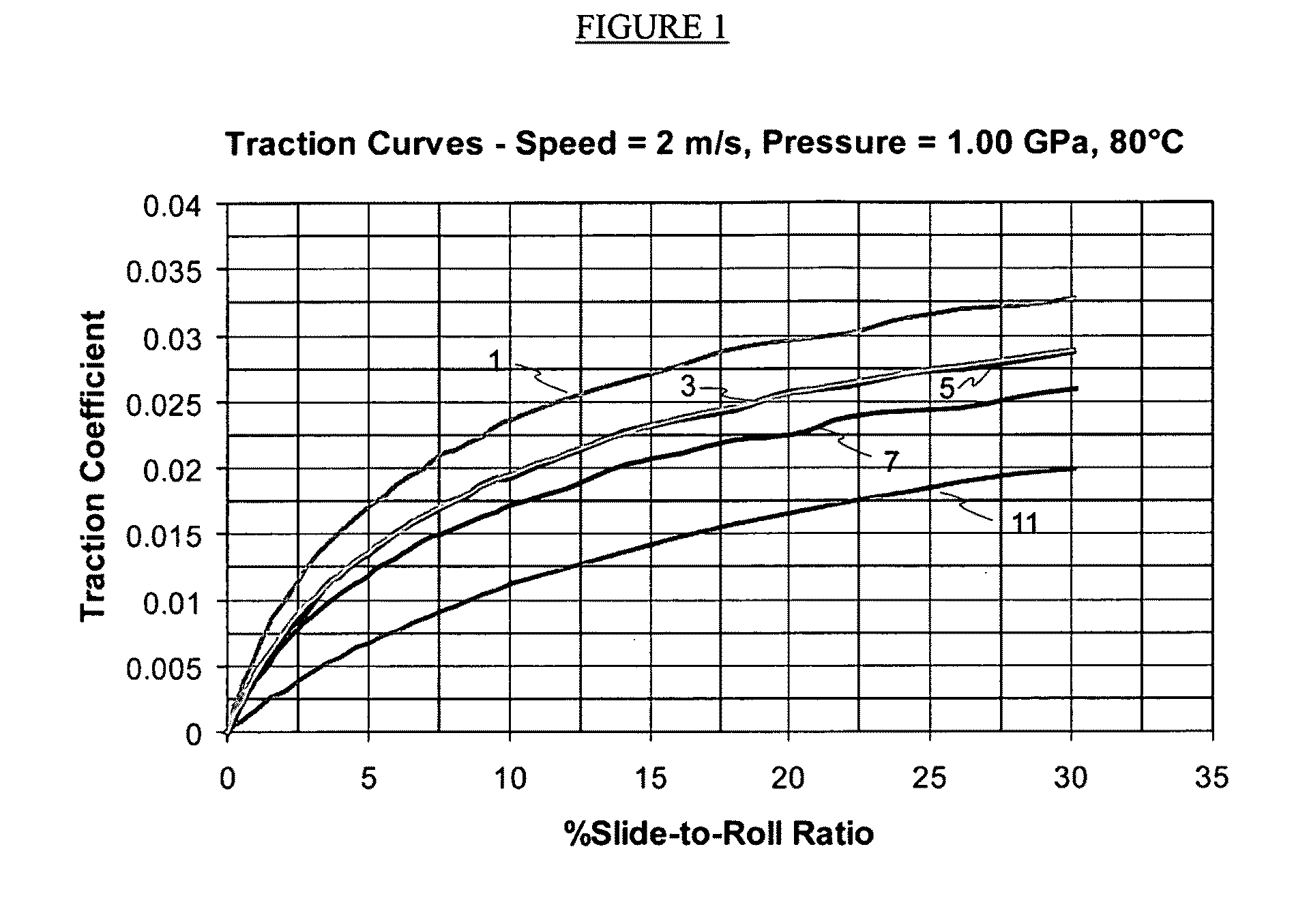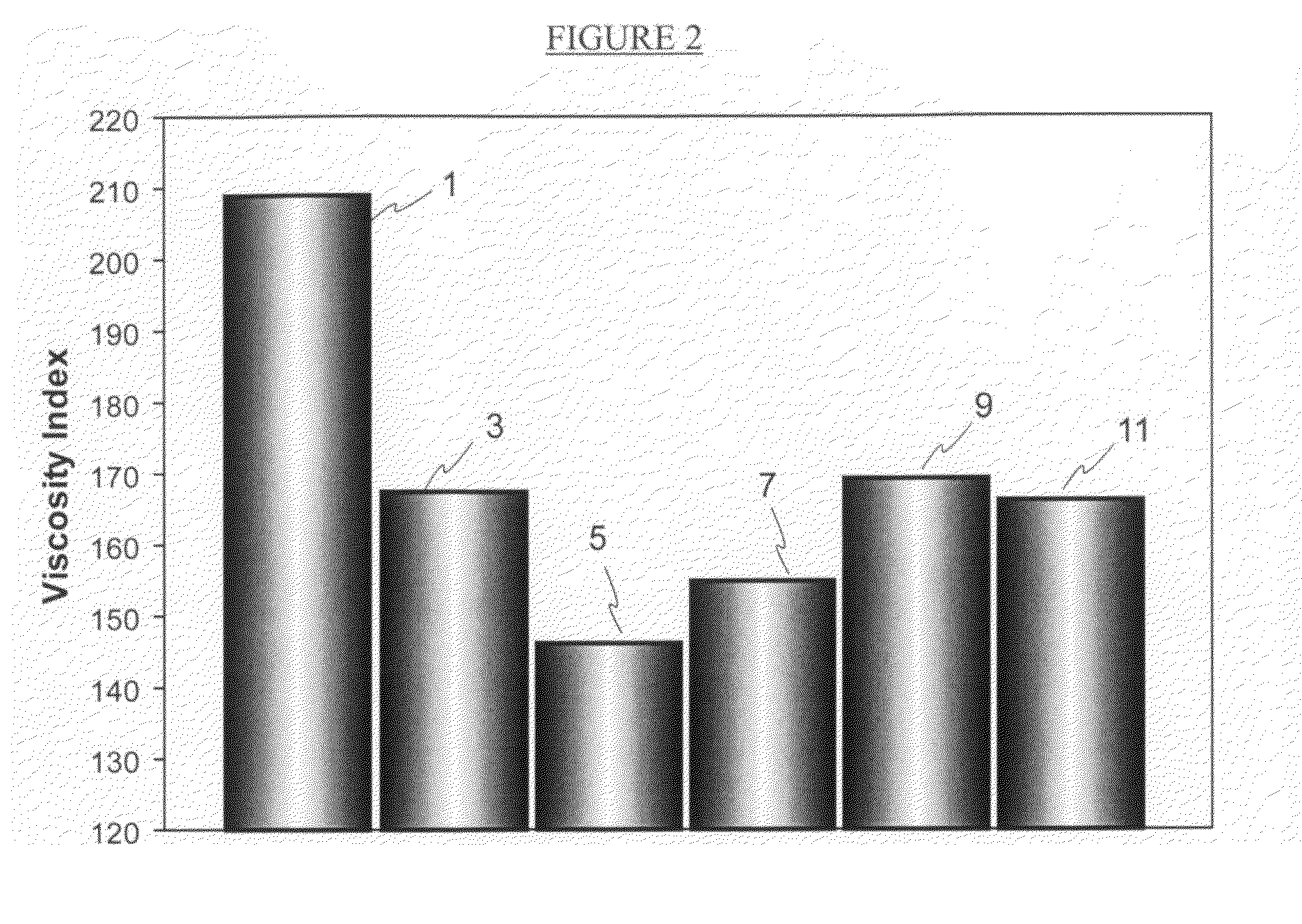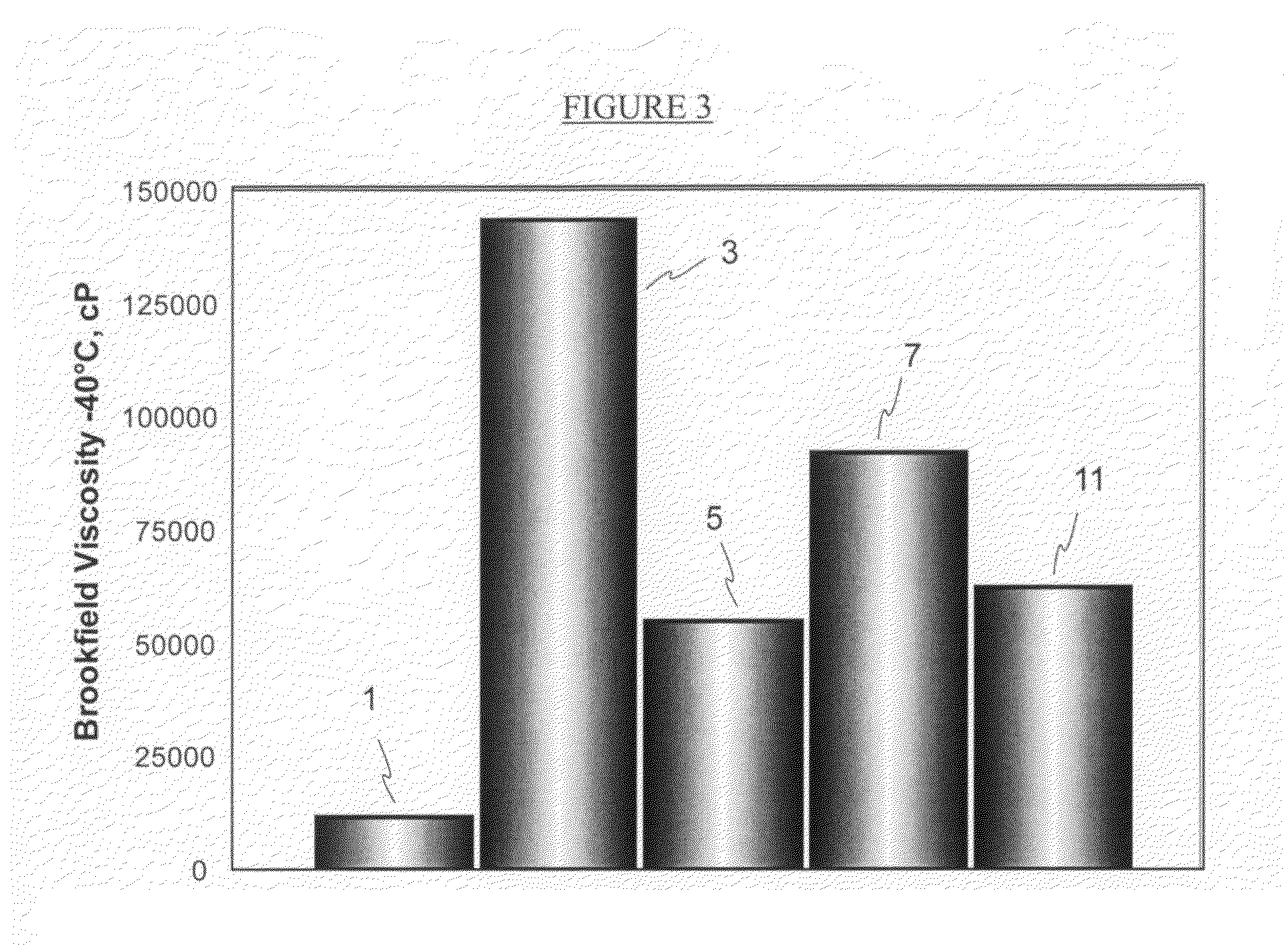[0048]The viscosity grade of the final product is adjusted by suitable blending of base stock components of differing viscosities. In many conventional industrial lubricant formulations, thickeners are used to increase viscosity. One particular advantage of the present invention is that thickeners are not necessary and in preferred embodiments no thickeners are used. HVI-PAO fluids of different viscosity grades are most suitably used to achieve wide finished viscosity grades with significant performance advantages. Usually, differing amounts of the various basestock components (primary hydrocarbon base stocks, secondary base stock and any additional base stock components) of different viscosities, may be suitably blended together to obtain a base stock blend with a viscosity appropriate for blending with the other components (such as described below) of the finished lubricant. This may be determined by one of ordinary skill in the art in possession of the present disclosure without undue experimentation. The viscosity grades for the final product are preferably in the range of ISO 2 to ISO 1000 or even higher for industrial gear lubricant applications, for example, up to about ISO 46,000. For the lower viscosity grades, typically from ISO 2 to ISO 100, the viscosity of the combined base stocks will be slightly higher than that of the finished product, typically from ISO 2 to about ISO 220 but in the more viscous grades up to ISO 46,000, the additives will frequently decrease the viscosity of the base stock blend to a slightly lower value. With a ISO 680 grade lubricant, for example, the base stock blend might be about 780-800 cSt (at 40° C.) depending on the nature and content of the additives.
[0049]In conventional formulations, the viscosity of the final product may be brought to the desired grade by the use of polymeric thickeners especially in the product with the more viscous grades, e.g. from ISO 680 to ISO 46,000. Typical thickeners which may be used include the polyisobutylenes, as well as ethylene-propylene polymers, polymethacrylates and various diene block polymers and copolymers, polyolefins and polyalkylstyrenes. These thickeners are commonly used as viscosity index improvers (“VI”) improvers or viscosity index modifiers (VIMs) so that members of this class conventionally confer a useful effect on the temperature-viscosity relationship. Although optionally used in formulations according to the present invention, such components may be blended according commercial market requirement, equipment builder specifications to produce products of the final desired viscosity grade. Typical commercially available viscosity index improvers are polyisobutylenes, polymerized and co-polymerized alkyl methacrylates, and mixed esters of styrene maleic anhydride interpolymers reacted with nitrogen containing compounds.
[0050]The polyisobutenes, normally with a number average or weight average molecular weight from 10,000 to 15,000, are a commercially important class of VI improvers and generally confer strong viscosity increases as a result of their molecular structure. The diene polymers which are normally copolymers of 1,3-dienes such as butadiene or isoprene, either alone or copolymerized with styrene are also an important class commercially, with typical members of this class sold under names such as Shelivis™. The statistical polymers are usually produced from butadiene and styrene while the block copolymers are normally derived from butadiene / isoprene and isoprene / styrene combinations. These polymers are normally subjected to hydrogenation to remove residual diene unsaturation and to improve stability. The polymethacrylates, normally with number average or weight average molecular weights from 15,000 to 25,000, represent another commercially important class of thickeners and are widely commercially available under designations such as Acryloid™.
[0051]One class of polymeric thickeners is the block copolymers produced by the anionic polymerization of unsaturated monomers including styrene, butadiene, and isoprene. Copolymers of this type are described, for instance, in U.S. Pat. Nos. 5,187,236; 5,268,427; 5,276,100; 5,292,820; 5,352,743; 5,359,009; 5,376,722 and 5,399,629. Block copolymers may be linear or star type copolymers and for the present purposes, the linear block polymers are preferred. The preferred polymers are the isoprene-butadiene and isoprene-styrene anionic diblock and triblock copolymers. Particularly preferred high molecular weight polymeric components are the ones sold under the designation Infineum SV by Infinium Chemical Company, which are linear anionic copolymers. Of these, Infinium SV is an anionic diblock copolymer and is Infineum SV are star copolymers.
[0052]Some thickeners may be classified as dispersant-viscosity index modifiers because of their dual function, as described in U.S. Pat. No. 4,594,378. The dispersant-viscosity index modifiers disclosed in the '378 patent are the nitrogen-containing esters of carboxylic-containing interpolymers and the oil-soluble acrylate-polymerization products of acrylate esters, alone or in combination. Commercially available dispersant-viscosity index modifiers are sold under trade names Acryloid™ 1263 and 1265 by Rohm and Haas, Viscoplex™ 5151 and 5089 by Rohm-GMBHO™ Registered™ and Lubrizol™ 3702 and 3715.
[0053]Antioxidants, although optional, may be used to improve the oxidative stability of formulations according to the present invention. A wide range of commercially available materials is suitable. The most common types of antioxidant which may be used in the present compositions are the phenolic antioxidants, the amine type antioxidants, the alkyl aromatic sulfides, phosphorus compounds such as the phosphites and phosphonic acid esters and the sulfur-phosphorus compounds such as the dithiophosphates and other types such as the dialkyl dithiocarbamates, e.g. methylene bis(di-n-butyl) dithiocarbamate. They may be used individually by type or in combination with one another. Mixtures of different types of phenols or amines are particularly preferred.
 Login to View More
Login to View More 


